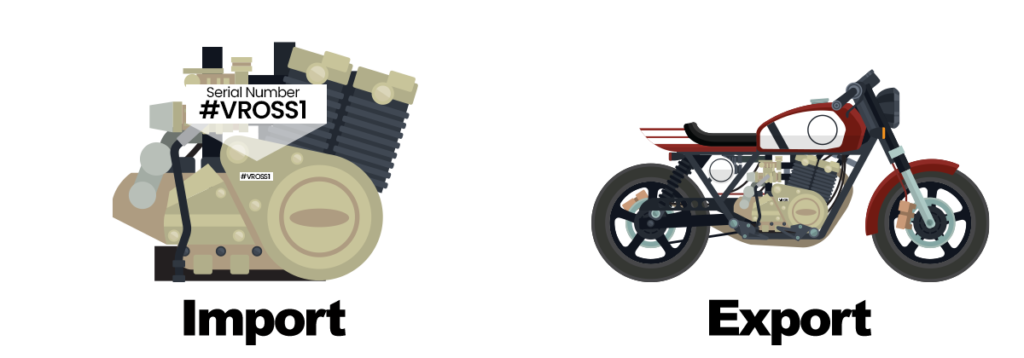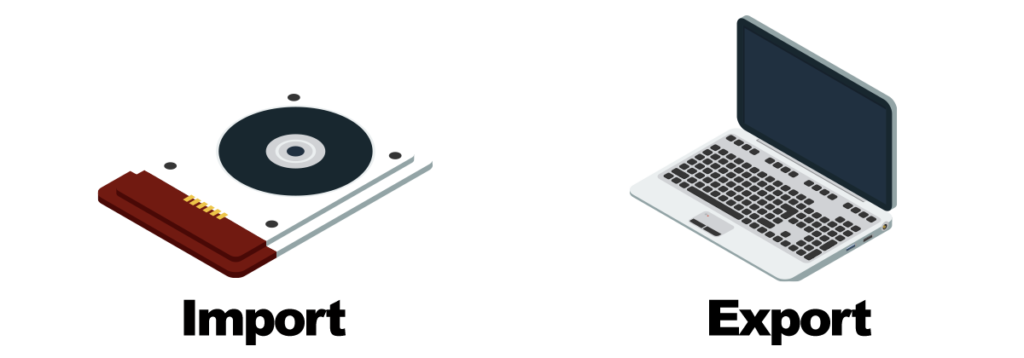Manufacturing Drawback Explained
The Manufacturing Drawback filing provision utilizes raw materials and component parts that are used to make a new and different article of commerce that is subsequently exported. The production process must result in a product with either a new name, character, or use.
Here’s an Example of Manufacturing Drawback
Duty Paid Raw Materials and Components Used in Exported Finished Goods

Serialized motors are imported duty paid into the United Stated, assembled into a motorcycle and then exported to Italy.
Manufacturing Direct Identification
Provision: 19 USC 1313(a)
Using Manufacturing Direct Identification, the imported component that is contained in the exported finished product is traced back to importation using a lot number or serial number. If imported components lose their identity when entered into inventory, then the claimant must use one of the accepted drawback accounting methods, such as FIFO or LIFO, to comply with the requirements of Direct Identification.

Hard drive components are imported duty paid into the United Stated and installed into a laptop. Imported duty paid components sharing the same HTS can be matched or substituted for the exported finished good.
Manufacturing Substitution
Provision: 19 USC 1313(b)
When filing under the provisions of Manufacturing Substitution, components, regardless or origin, used in the production of a finished good can be matched to the duty paid imported component using HTS level Substitution.
Manufacturing Drawback Rulings
A Claimant Must Secure a Ruling to File Under the Provisions of Manufacturing Drawback
General Manufacturing Ruling
General manufacturing drawback rulings are designed to simplify drawback for certain common manufacturing operations. As an example, manufacturers assembling finished products from component parts can file under an existing general ruling. A manufacturer or producer engaged in an operation that falls within a published general manufacturing drawback ruling simply submits a letter of notification of intent to operate under that general ruling.
Specific Manufacturing Ruling
If the manufacturing operations of the company fall outside one of the general rulings, then the claimant must seek a specific ruling approval from Customs headquarters.
The Regulatory Language of Manufacturing Drawback
§ 190.21 Direct identification manufacturing drawback
Section 313(a) of the Act, as amended (19 U.S.C. 1313(a)), provides for drawback upon the exportation, or destruction under CBP supervision, of articles manufactured or produced in the United States with the use of imported merchandise, provided that those articles have not been used in the United States prior to such exportation or destruction. The amount of drawback allowable will not exceed 99 percent of the amount of duties, taxes, and fees paid with respect to the imported merchandise. However, duties may not be refunded upon the exportation or destruction of flour or by-products produced from imported wheat. Where two or more products result, drawback must be distributed among the products in accordance with their relative values, as defined in § 190.2, at the time of separation. Merchandise may be identified for drawback purposes under 19 U.S.C. 1313(a) in the manner provided for and prescribed in § 190.14.
§ 190.22 Substitution drawback
(a)
(1) General –
(i) Substitution standard. If imported, duty-paid merchandise or merchandise classifiable under the same 8-digit HTSUS subheading number as the imported merchandise is used in the manufacture or production of articles within a period not to exceed 5 years from the date of importation of such imported merchandise, then upon the exportation, or destruction under CBP supervision, of any such articles, without their having been used in the United States prior to such exportation or destruction, drawback is provided for in section 313(b) of the Act, as amended (19 U.S.C. 1313(b)). Drawback is allowable even though none of the imported, duty-paid merchandise may actually have been used in the manufacture or production of the exported or destroyed articles. The amount of duties, taxes, and fees eligible for drawback is determined by per unit averaging, as defined in § 190.2, for any drawback claim based on 19 U.S.C. 1313(b).
(ii) Allowable refund –
(A) Exportation. In the case of an article that is exported, the amount of drawback allowable will not exceed 99 percent of the lesser of:
(1) The amount of duties, taxes, and fees paid with respect to the imported merchandise; or
(2) The amount of duties, taxes, and fees that would apply to the substituted merchandise if the substituted merchandise were imported.
(B) Destruction. In the case of an article that is destroyed, the amount of drawback allowable will not exceed 99 percent of the lesser of:
(1) The amount of duties, taxes, and fees paid with respect to the imported merchandise (after the value of the imported merchandise has been reduced by the value of materials recovered during destruction as provided in 19 U.S.C. 1313(x)); or
(2) The amount of duties, taxes, and fees that would apply to the substituted merchandise if the substituted merchandise were imported (after the value of the imported merchandise has been reduced by the value of materials recovered during destruction as provided in 19 U.S.C. 1313(x)).
(C) Federal excise tax. For purposes of drawback of internal revenue tax imposed under Chapters 32, 38 (with the exception of Subchapter A of Chapter 38), 51, and 52 of the Internal Revenue Code of 1986, as amended (IRC), drawback granted on the export or destruction of substituted merchandise will be limited to the amount of taxes paid (and not returned by refund, credit, or drawback) on the substituted merchandise.
(2) Special rule for sought chemical elements –
(i) Substitution standard. A sought chemical element, as defined in § 190.2, may be considered imported merchandise, or merchandise classifiable under the same 8-digit HTSUS subheading number as such imported merchandise, used in the manufacture or production of an article as described in paragraph (a)(1)(i) of this section, and it may be substituted for source material containing that sought chemical element, without regard to whether the sought chemical element and the source material are classifiable under the same 8-digit HTSUS subheading number, and apportioned quantitatively, as appropriate (see § 190.26(b)(4)).
(ii) Allowable refund. The amount of drawback allowable will be determined in accordance with paragraph (a)(1)(ii) of this section. The value of the substituted source material must be determined based on the quantity of the sought chemical element present in the source material, as calculated per § 190.26(b)(4).
(b) Use by same manufacturer or producer at different factory. Duty-paid merchandise or drawback products used at one factory of a manufacturer or producer within 5 years after the date on which the material was imported may be designated as the basis for drawback on articles manufactured or produced in accordance with these regulations at other factories of the same manufacturer or producer.
(c) Designation. A manufacturer or producer may designate any eligible imported merchandise or drawback product which it has used in manufacture or production.
(d) Designation by successor –
(1) General rule. Upon compliance with the requirements in this section and under 19 U.S.C. 1313(s), a drawback successor as defined in paragraph (d)(2) of this section may designate merchandise or drawback product used by a predecessor before the date of succession as the basis for drawback on articles manufactured or produced by the successor after the date of succession.
(2) Drawback successor. A “drawback successor” is a manufacturer or producer to whom another entity (predecessor) has transferred, by written agreement, merger, or corporate resolution:
(i) All or substantially all of the rights, privileges, immunities, powers, duties, and liabilities of the predecessor; or
(ii) The assets and other business interests of a division, plant, or other business unit of such predecessor, but only if in such transfer the value of the transferred realty, personalty, and intangibles (other than drawback rights, inchoate or otherwise) exceeds the value of all transferred drawback rights, inchoate or otherwise.
(3) Certifications and required evidence –
(i) Records of predecessor. The predecessor or successor must certify that the successor is in possession of the predecessor’s records which are necessary to establish the right to drawback under the law and regulations with respect to the merchandise or drawback product.
(ii) Merchandise not otherwise designated. The predecessor or successor must certify that the predecessor has not designated and will not designate, nor enable any other person to designate, such merchandise or product as the basis for drawback.
(iii) Value of transferred property. In instances in which assets and other business interests of a division, plant, or other business unit of a predecessor are transferred, the predecessor or successor must specify, and maintain supporting records to establish, the value of the drawback rights and the value of all other transferred property.
(iv) Review by CBP. The written agreement, merger, or corporate resolution, provided for in paragraph (d)(2) of this section, and the records and evidence provided for in paragraph (d)(3)(i) through (iii) of this section, must be retained by the appropriate party(s) for 3 years from the date of liquidation of the related claim and are subject to review by CBP upon request.
(e) Multiple products –
(1) General. Where two or more products are produced concurrently in a substitution manufacturing operation, drawback will be distributed to each product in accordance with its relative value (see § 190.2) at the time of separation.
(2) Claims covering a manufacturing period. Where the claim covers a manufacturing period rather than a manufacturing lot, the entire period covered by the claim is the time of separation of the products and the value per unit of product is the market value for the period (as provided for in the definition of relative value in § 190.2). Manufacturing periods in excess of one month may not be used without specific approval of CBP.
(3) Recordkeeping. Records must be maintained showing the relative value of each product at the time of separation.
19 CFR Part 190 – Modernized Drawback”
https://www.ecfr.gov/current/title-19/chapter-I/part-190
Claim Your Manufacturing Duty Drawback
No cost or obligation and easy to get started with Alliance. Identify new drawback program opportunity or evaluate the performance of your current program and maximize drawback refunds compliantly.
